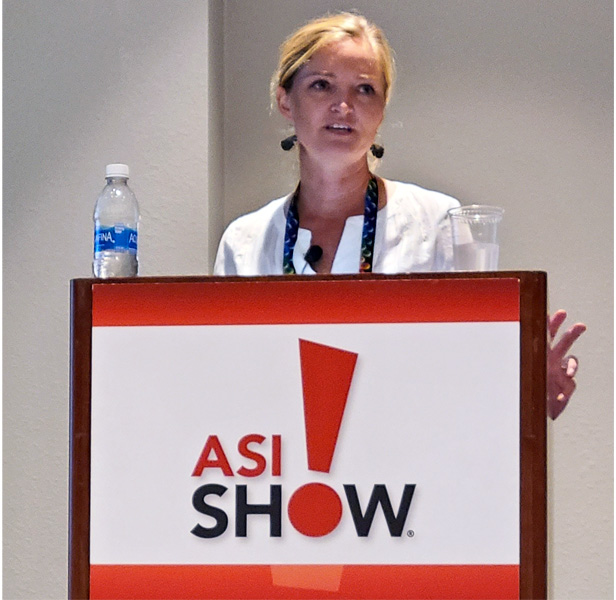July 26, 2023
ASI Chicago 2023: Dispelling the Myths Around Business Valuation
Jamie Watson of Certified Marketing Consultants shared some of the biggest misconceptions when it comes to building your company’s value.
With more than a dozen years consulting on mergers and acquisitions in the promo industry, Jamie Watson has seen more than her share of myths and misconceptions.
During an education session at ASI Chicago, the partner at Certified Marketing Consultants (asi/44526) shared some tough love about business valuation for promo companies – and why running your company with an eye toward an eventual sale in the future also makes it much easier to run, more sustainable and resilient in the present.

Here are seven of the many myths Watson dispelled during her session.
Myth: Sales growth is the ultimate measure of how successful my company is.
In reality, sales growth is just one of many metrics that will be looked at in valuing your company. It’s important to have a handle on other aspects of your finances, including things like gross margin, adjusted net income and cash flow.
“Yes, [potential buyers] look at the top line, but they base the price on the bottom line, almost exclusively,” Watson said. “You can’t just focus on sales.”
She also cautioned attendees from growing their companies too quickly, without having a solid foundation and ability to scale. Too often, such businesses are doomed to fail. “I’ve seen this time and time again,” she said. “You can’t really outsell low margins.”
Myth: The longevity of my company makes it valuable.
A company that’s weathered many decades is certainly something to be proud of, Watson said, but years in business alone doesn’t automatically translate into value. “You don’t get another $10,000 for every year you’ve been in business,” she added.
If your business has been around for 20 years but hasn’t seen healthy and consistent growth in that time, it will make potential buyers skeptical of whether it’s scalable or worthy of investment. “In the buying world, one plus one is three is what people are looking for,” Watson said.
Longtime companies that haven’t kept up with advances in technology could also be looking at a loss in value, since any buyer would likely have to make those upgrades to stay competitive. Watson added that her firm advises companies to stay on the “leading edge but not the bleeding edge” of technology.
Myth: Untapped potential makes my company more valuable to a buyer.
Unexplored opportunities will leave buyers with questions – chiefly, why weren’t those opportunities explored while the original owner was in charge? If the owner is willing to stay on with their company for a short time – maybe two or three years – to help bring that potential to fruition, they could receive a contingency payment in return, Watson said.
Myth: I’m a sales and marketing person, so I don’t need to understand “the numbers.”
All business owners need to have a basic understanding of the numbers, including things like sales management, understanding and monitoring gross margin, net income and cash flow and what’s being captured on financial statements and whether it’s in line with expectations and goals.
Watson suggested putting together a budget on a monthly basis, rather than annual basis, so business owners have a better handle on when dips and swells in revenue typically occur. “One tip is after the month is finished, budget that month for next year while it’s still fresh in your mind,” Watson said. “Then you don’t have a long budgeting process that takes forever at the end of the year.”
Myth: One large customer is better than lots of small customers.
Oftentimes, distributors get their start by finding one large customer and growing from there. It’s a fine starting point, Watson said, but in the long-term it can be very risky to put all your eggs in one basket.
Instead, you should look to diversify and grow your customer base. Many distributors rely on word-of-mouth for new business, but Watson recommended putting a strong customer acquisition strategy in place – something that’s routine and repeatable that can bring in leads and results.
Myth: I don’t need a banking relationship because my company makes money.
It’s important to note, Watson said, that income and cash flow are two different things. A business could be making money without positive cash flow due to factors like slow collection of receivables, carrying inventory or investment in equipment.
“Having a banking relationship is never going to hurt you,” Watson said. “You can be debt averse and still have line of credit out there waiting if you ever need it.”
She advised business owners to finance long-term assets like equipment and building purchases with long-term notes, but finance short-term assets like inventory with short-term debt, like a line of credit.
Myth: I own a small business, so it’s not worth having a succession plan.
Succession planning isn’t just about what’s going to happen to your company when you’re gone, it’s about what’s happening to your company now, Watson said. Developing a thoughtful plan can be valuable to the business owner, their employees and their customers. The plan can include things like a buy/sell agreement, transition to the next generation, selling to an employee or some other arrangement. And it’s not set in stone. Changes can be made down the line. But it’s important to start somewhere.
“Every business in this industry – unless it’s under water – is worth something,” Watson said.